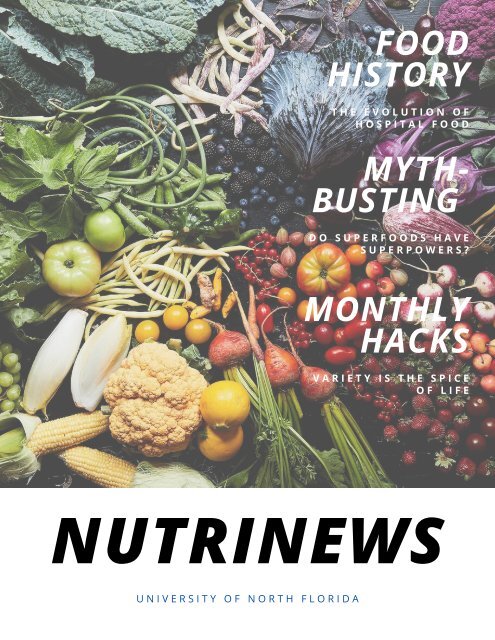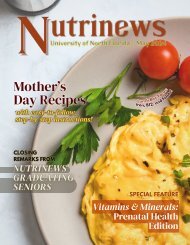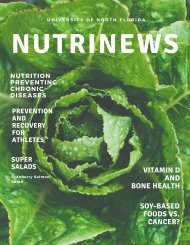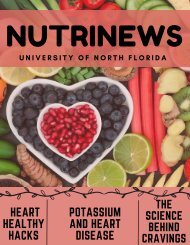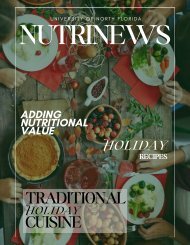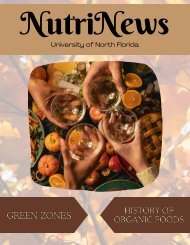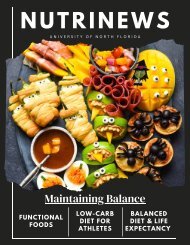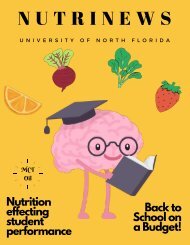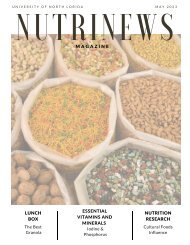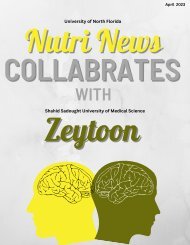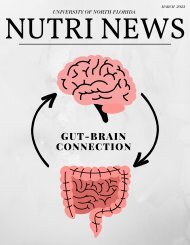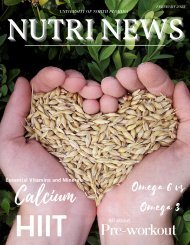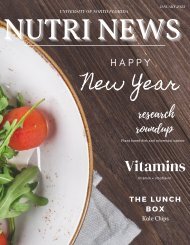march issue
Hello all! The theme for March is National Nutrition Month! Topics include How Nutrition Can Influence Our Health and The Evolution of Hospital Food. This month’s student spotlight is on our very own Alicia Blong. I hope you all enjoy, learn, and get inspired by this month’s articles and recipes!
Hello all!
The theme for March is National Nutrition Month! Topics include How Nutrition Can Influence Our Health and The Evolution of Hospital Food. This month’s student spotlight is on our very own Alicia Blong.
I hope you all enjoy, learn, and get inspired by this month’s articles and recipes!
Create successful ePaper yourself
Turn your PDF publications into a flip-book with our unique Google optimized e-Paper software.
FOOD<br />
HISTORY<br />
T H E E V O L U T I O N O F<br />
H O S P I T A L F O O D<br />
MYTH-<br />
BUSTING<br />
D O S U P E R F O O D S H A V E<br />
S U P E R P O W E R S ?<br />
MONTHLY<br />
HACKS<br />
V A R I E T Y I S T H E S P I C E<br />
O F L I F E<br />
NUTRINEWS<br />
U N I V E R S I T Y O F N O R T H F L O R I D A
Table of Contents<br />
2<br />
COVID CORNER<br />
Updated symptoms of<br />
COVID-19<br />
4<br />
NATIONAL<br />
NUTRITION MONTH<br />
UNF Wellness Dietitians<br />
7<br />
FOOD HISTORY<br />
The Evolution of Hospital<br />
Food<br />
9<br />
FACULTY SPOTLIGHT<br />
An interview with Dr. Christie<br />
14<br />
THE LUNCH BOX<br />
Recipe: Asian Carrot and Red<br />
Cabbage Slaw<br />
15<br />
MONTHLY HACKS<br />
Variety Is the Spice of Life<br />
17<br />
SHOPPING IN<br />
SEASON<br />
Herbs<br />
27<br />
INTERVIEW<br />
An interview with Professor<br />
Martha Altamiroano from<br />
Guadalajara Mexico<br />
19<br />
STUDENT<br />
SPOTLIGHT<br />
An Interview with Alicia<br />
Blong<br />
33<br />
SPORTS NUTRITION<br />
When Does Nutrition<br />
Become Sports Nutrition?<br />
23<br />
NUTRITION<br />
RESEARCH<br />
How Nutrition Can Influence<br />
Our Health<br />
34<br />
MYTHBUSTING<br />
Do superfoods have<br />
superpowers?<br />
36<br />
COLLABORATION WITH<br />
IRANIAN NUTRITION<br />
STUDENTS<br />
40<br />
NUTRINEWS STAFF<br />
Meet our staff!<br />
The Persian New Year
Women's History<br />
Month
Happy International<br />
WOMEN'S<br />
DAY<br />
March 8th, 2022
3<br />
Symptoms tend to manifest about 5-6 day after infection of COVID-19, but it can take up to 14<br />
days to be symptomatic. As for getting tested, there are free testing sites on campus in the<br />
student health services center and other locations (see source 2). Also, free at-home COVID-19<br />
tests are provided by the Government through requests at COVIDTests.gov with four tests per<br />
household.<br />
Remember, the things that we can do to avoid COVID-19 and getting sick is wearing a mask,<br />
washing our hands, and staying 6-feet away from everyone. However, recommendations for<br />
everyone still include getting your vaccinations and booster (see January 2022’s <strong>issue</strong> of<br />
NutriNews for more information on the Booster Shots) because in the vaccinated4, symptoms are<br />
mild and in unvaccinated people they can be more severe anc could lead to higher rates of<br />
hospitalization (or death)!<br />
We all want to keep in person classes and get back some sense of normalcy in a pandemic world<br />
but, we can’t do that without continuing to work together and ensure that we are all happy and<br />
healthy! Wear your mask, know the symptoms, and get tested if necessary!<br />
References:<br />
1. World. Coronavirus. Who.int. Published January 10, 2020. Accessed January 27, 2022. https://www.who.int/healthtopics/coronavirus#tab=tab_3<br />
2. Free COVID-19 Testing on Campus. UNF Coronavirus. Published January 18, 2022. Accessed January 27, 2022.<br />
https://www.unf.edu/coronavirus/testing.html<br />
3. HHS. COVIDtests.gov. COVIDtests.gov. Published 2022. Accessed January 27, 2022. https://www.covidtests.gov/<br />
4. Coronavirus. COVID-19 symptoms | Coronavirus | UC Davis Health. Ucdavis.edu. Published 2021. Accessed January<br />
27, 2022. https://pulmonary.ucdavis.edu/coronavirus/covid-19-information/coronavirus-symptoms
14<br />
The Lunch Box:<br />
Asian Carrot and<br />
Red Cabbage<br />
Slaw<br />
INSTRUCTIONS<br />
INGREDIENTS<br />
1.<br />
Thinly slice red cabbage<br />
2 cups shredded red cabbage<br />
Thinly slice green onion<br />
2.<br />
1 carrot shredded (can buy pre-shredded)<br />
3.<br />
2 medium scallions<br />
Shred carrot (if not pre-shredded)<br />
1/2 tsp minced garlic<br />
Mince garlic<br />
4.<br />
5.<br />
2 inches of fresh ginger, grated<br />
Grate ginger<br />
1 tsp lemon juice<br />
Thoroughly combine red cabbage, scallion,<br />
6.<br />
carrot, garlic, and ginger<br />
4 tbsp soy sauce<br />
Add soy sauce, rice vinegar, lemon juice,<br />
2 tbsp rice vinegar<br />
7.<br />
2 tbsp sesame oil<br />
sesame oil, and honey<br />
Cool for one hour and serve with toasted<br />
8.<br />
3 tbsp honey<br />
Toasted almonds (optional)<br />
almonds and sesame seeds if desired<br />
Toasted sesame seeds (optional)<br />
By: Paige Courtier
15<br />
M o n t h l y H a c k s<br />
<br />
V a r i e t y I s t h e S p i c e o f L i f e<br />
B y : M e l i s s a B r e n n a n , M . S .<br />
Now that March is here, National Nutrition Month is in full<br />
swing! Adding nutrient dense foods into your meal rotation<br />
is a great way to celebrate this month and all year long.<br />
Nutrient-dense foods are more than just fruits and<br />
vegetables. These foods contain beneficial nutrients like<br />
vitamins, minerals, and antioxidants. Dark chocolate and<br />
teas contain these nutrients as well. Here a few fun ways<br />
to incorporate more nutrient-dense foods into your diet:<br />
Find fun recipe books that appeal to your<br />
preferences:<br />
Everyone from Snoop Dogg to Joanna Gaines has<br />
cookbooks filled with delicious recipes that offer a variety<br />
of dishes. Trying out popular dishes from different<br />
cultures or even perusing Disney’s website can offer fun<br />
and new recipes to try out. Disney’s blog has a simple<br />
recipe for recreating their iconic Dole Whip with nutrientdense<br />
ingredients. It can be found at:<br />
https://cdn1.parksmedia.wdprapps.disney.com/media/blo<br />
g/wpcontent/uploads/2021/07/Dole_Whip_Pineapple_Treat_R<br />
ECIPE.pdf<br />
Try new flavor combinations:<br />
Eating nutrient-dense foods that satisfy your preferences<br />
and needs does not have to be boring! Looking over<br />
recipe blogs or a quick Google search can help you think<br />
up interesting flavor combinations you have never tried<br />
before. For example, you could explore strawberries<br />
drizzled with balsamic vinegar, cheese with honey, or<br />
pear and arugula on flatbreads. Don’t be afraid to season<br />
foods with unique spices as well.
Picking out a new spice at the grocery store and incorporating into your existing meal rotations can be a<br />
fun way to add in more nutrient-dense foods while exploring different ways of preparing your standard<br />
food choices. If you need a little spark of inspiration, you could pick up cardamom for your morning oats<br />
or herbs de Provence for roasted vegetables or seafood.<br />
The world is your oyster!<br />
Try one new food a week.<br />
Getting into food ruts and jags is common when busy with school and work and living an academicscentered<br />
lifestyle. Another easy and fun way to incorporate more nutrient-dense foods into your diet is<br />
to try one new food a week. Taking a walk around the produce section of the grocery store can reveal<br />
some new fruits or vegetables you never tried before that you are interested in. Grabbing a pitaya<br />
(dragon fruit) or Romanesco (broccoli) and trying different preparation methods can increase the variety<br />
in your diet, and you may find a new favorite food in the process! Consuming familiar foods alongside<br />
your new food picks as you get introduced to them can help facilitate the process of expanding your<br />
palate. That could look like making a mini charcuterie board and adding a few slices of pitaya to the<br />
spread or adding in the Romanesco broccoli to a pasta dish you already love.<br />
Variety is the spice of life, so get creative! There are no food rules; have fun and experiment with foods<br />
and recipes that are new to you. This can be a great way to add more nutrient-dense foods to your diet.<br />
16
INTERNATIONAL DAY<br />
of<br />
NOWRUZ<br />
THE FIRST DAY OF SPRING<br />
MARCH 21, 2022
17<br />
Shopping in Season: Herbs<br />
By: Laura Rogers<br />
Before we ease into the hot Florida summer, delicate herbs are ready for<br />
harvest. Chives, cilantro, dill, rosemary, basil, and mint are popular varieties<br />
that can be easily grown here in Northeast Florida. Whether you have a plot<br />
in your backyard, a small patio garden, or a few pots on a windowsill, herbs<br />
are excellent for gardeners at any level.<br />
Technically, a herb is the leaf portion of a plant, while a spice is any other<br />
portion of the plant and is most commonly dried.1 Throughout history, herbs<br />
have been used for medicinal and culinary purposes. Fresh herbs can be<br />
utilized to upgrade any recipe with a full-bodied flavor. Furthermore,<br />
individuals trying to reduce the amount of salt, fat, or sugar in their diet will<br />
often turn to herbs for the dynamic flavor profile they add to dishes.<br />
However, since herbs are delicate, adding them in at the end of cooking<br />
retains a significant amount of their potency.1<br />
Over time, herbs have been researched and experimented with to uncover their<br />
medicinal properties. Chronic inflammation is the culprit of many diseases, which is<br />
why there are currently many researchers studying the potential antioxidant and antiinflammatory<br />
properties of herbs. To downregulate the body’s overactive<br />
inflammatory response, which causes chronic inflammation, these aromatic plants have<br />
the potential to be easily accessed, are cost-effective, and exhibit fewer side effects<br />
than synthetics. Therefore, researchers are pursuing to uncover herbal mechanisms of<br />
action associated with anti-inflammatory pathways 2. Even though there are countless<br />
studies pertaining to herbs and their anti-inflammatory properties, controlled studies<br />
are limited by their cost and level of difficulty.3 However, many herbs have been<br />
found to have anti-inflammatory properties, but the amount of bioactivity is<br />
dependent upon plant breeding, cultivation techniques, and harvesting; unfortunately,<br />
agriculture focuses less on bioactive compounds and more on the yield and appearance<br />
of crops.3
Whether you utilize herbs as a functional food to improve your health or to simply<br />
enjoy the vibrant taste they provide, next time you cook a dish, impress your family<br />
and friends with the simple culinary addition of herbs. Try this version of a<br />
traditional Lebanese tabbouleh salad featuring parsley and mint:4<br />
Tabbouleh Salad<br />
INGREDIENTS:<br />
¼ cup fine bulgur wheat<br />
1 small garlic clove, minced (optional)<br />
Juice of 2 large lemons, to taste<br />
3 cups chopped fresh flat-leaf parsley (from 3 large bunches)<br />
¼ cup chopped fresh mint<br />
½ pound ripe tomatoes, very finely chopped<br />
1 bunch scallions, finely chopped<br />
Salt, preferably kosher salt, to taste<br />
¼ cup extra virgin olive oil<br />
1 romaine lettuce heart, leaves separated, washed, and dried<br />
PREPARATION:<br />
- Place the bulgur in a bowl, and cover with water by 1/2 inch. Soak for 20 minutes, until slightly softened. Drain<br />
through a cheesecloth-lined strainer and press the bulgur against the strainer to squeeze out excess water.<br />
- Transfer to a large bowl, and toss with the garlic, lemon juice, parsley, mint, tomatoes, scallions, and salt.<br />
- Leave at room temperature or in the refrigerator for two to three hours so that the bulgur can continue to<br />
absorb liquid and swell.<br />
-Add the olive oil, toss together, taste, and adjust seasonings. Serve with lettuce leaves.<br />
Tip* This will keep for a day in the refrigerator, though the bright green color will fade because of the lemon<br />
juice.<br />
References:<br />
1. Herbs. Better health channel. https://www.betterhealth.vic.gov.au/health/healthyliving/herbs Reviewed December 15, 2021. Accessed January 30, 2022<br />
2. Yatoo MI, Gopalakrishnan A, Saxena A, et al. Anti-inflammatory drugs and herbs with special emphasis on herbal medicines for countering inflammatory diseases and<br />
disorders - a review. Recent Pat Inflamm Allergy Drug Discov. 2018;12(1):39-58. https://doi.org/10.2174/1872213X12666180115153635<br />
3. Jungbauer A, Medjakovic S. Anti-inflammatory properties of culinary herbs and spices that ameliorate the effects of metabolic syndrome. Maturitas. 2012;71(3):227-<br />
239. https://doi.org/10.1016/j.maturitas.2011.12.009<br />
4. Shulman MR. Lebanese tabbouleh. NYT Cooking. https://cooking.nytimes.com/recipes/1012585-lebanese-tabbouleh Accessed January 30, 2022<br />
18
23<br />
NUTRITION<br />
RESEARCH<br />
HOW NUTRITION CAN INFLUENCE<br />
OUR HEALTH<br />
Many people have heard, “nutrition is<br />
important,” just like many people have<br />
heard, “eating fruits and vegetables is<br />
good for you”. But beyond that, do most<br />
people know why nutrition is important?<br />
One reason nutrition is so important is<br />
that adhering to healthy dietary patterns<br />
(as well as other lifestyle factors like<br />
physical activity, stress management,<br />
and proper rest) can help prevent the<br />
development of many chronic diseases.<br />
The major diet-related chronic diseases<br />
are diabetes, cardiovascular disease,<br />
and some types of cancer.1 By following<br />
a diet high in fruits, vegetables, whole<br />
grains, lean protein, and low and nonfat<br />
dairy, one can reduce the risks of<br />
developing these diseases. Although it’s<br />
important to note that diet isn’t the only<br />
factor that leads to chronic disease<br />
development, it is one of the factors that<br />
we have the most control over.<br />
By: Haley Brock
24<br />
Cardiovascular disease (CVD) includes<br />
coronary heart disease, stroke, and<br />
heart failure and is the primary cause of<br />
mortality, disability, and morbidity in<br />
developed countries.2 Risk factors for<br />
CVD are high blood pressure, type 2<br />
diabetes, inflammation, and<br />
hypercholesterolemia.2 Several studies<br />
show that those who eat diets rich in<br />
fish and nutrient-dense minimally<br />
processed plant foods have a lower risk<br />
of developing those risk factors and<br />
CVD.2 In addition, the consumption of<br />
omega-3 fatty acids and some<br />
phytochemicals have anti-inflammatory<br />
and anti-thrombotic effects that can<br />
reduce the risk of developing CVD.2<br />
Omega-3 fatty acids are found in plant<br />
oils, nuts and seeds, and fish.<br />
Phytochemicals are naturally-occurring<br />
compounds found in plants and plant<br />
foods like vegetables and plant oils. The<br />
Mediterranean diet, which recommends<br />
high consumption of grains, legumes,<br />
fruits, nuts, and vegetables and limited<br />
meat consumption, can decrease the<br />
risk of developing CVD by about 20-<br />
25%.3<br />
As of 2018, 34.2 million people of all<br />
ages (10.5% of the US population) had<br />
diabetes.4 Risk factors for diabetes<br />
include family history, genetics, age,<br />
race or ethnicity, inactivity, high blood<br />
pressure, and dietary patterns. Research<br />
shows that
25<br />
eating a diet that favors plant-based fats<br />
over animal fats can be more<br />
advantageous for the prevention and<br />
management of diabetes, as well as<br />
having a greater intake of omega-6<br />
polyunsaturated fatty acids instead of<br />
saturated fats. 5 Soluble fiber helps to<br />
reduce HbA1C and fasting plasma<br />
glucose, and a high fiber diet has been<br />
shown to reduce the risk of diabetes,<br />
especially when coming from whole<br />
grains.5 Abstaining from frequent<br />
consumption of red meat and processed<br />
meats (bacon, sausage, hot dogs) and<br />
consuming whole fruits and lots of<br />
vegetables (especially leafy greens) also<br />
have been associated with a lowered risk<br />
of developing diabetes.5<br />
Even aging can be influenced by our<br />
diet choices! If we’re going to discuss<br />
longevity, we must look at the Blue<br />
Zones—areas of the world with the<br />
longest-living populations. A common<br />
practice found across all Blue Zones<br />
is the consumption of a mainly plantbased<br />
diet with a lesser protein<br />
intake (0.8 grams per kg of body<br />
weight) than a typical Western diet.6<br />
The underlying mechanisms by which<br />
a plant-based diet promotes<br />
longevity and healthy aging is largely<br />
unknown and continues to be<br />
studied. Nutrient-sensing pathways<br />
appear to play an important role.
References<br />
26<br />
1. Neuhouser ML. The importance of healthy dietary patterns in chronic disease prevention. Nutr Res. 2019;70:3-6.<br />
doi.org/10.1016/j.nutres.2018.06.002.<br />
2. Rizza W, Veronese N, Fontana L. What are the roles of calorie restriction and diet quality in promoting healthy longevity? Ageing Res Rev.<br />
2014;13:38-45. doi:10.1016/j.arr.2013.11.002<br />
3. Rosato V, Temple NJ, La Vecchia C, Castellan G, Tavani A, Guercio V. Mediterranean diet and cardiovascular disease: a systematic review and<br />
meta-analysis of observational studies. Eur J Nutr. 2019;58:170-191. doi:10.1007/s00394-017-1582-0.<br />
4. National Diabetes Statistics Report 2020. Estimates of Diabetes and Its Burden in the United States. CDC website.<br />
https://www.cdc.gov/diabetes/pdfs/data/statistics/national-diabetes-statistics-report.pdf. Accessed February 2, 2022.<br />
5. Ley SH, Hamdy O, Mohan V, Hu FB. Prevention and management of type 2 diabetes: dietary components and nutritional strategies. Lancet.<br />
2014;383(9933):1999-2007. doi:10.1016/S0140-6736(14)60613-9.<br />
6. Liu T, Gatto NM, Chen Z, et al. Vegetarian diets, circulating MIRNA expression and healthspan in subjects living in the Blue Zone. Precis Clin<br />
Med. 2020;3(4):244-259. doi:10.1093/pcmedi/pbaa037.<br />
7. Fontana L, Partridge L. Promoting health and longevity through diet: from model organisms to humans. Cell. 2015;161(1):106-118. doi:10.1016/j.cell.2015.02.020.<br />
These are the pathways in the body used<br />
by organisms to respond to and utilize,<br />
organic molecules (glucose, lipids, amino<br />
acids) in order to generate energy or<br />
other needed cellular components.6<br />
New research suggests that protein<br />
restriction or restriction of specific<br />
amino acids in the diet can promote<br />
longevity in animal models by<br />
modulating IGF-related biological<br />
processes and disease risk in men and<br />
women, but more research on humans is<br />
needed.7<br />
Adequate nutrition can not only reduce<br />
your risk of developing chronic diseases<br />
and promote longevity in your life, but<br />
also help you feel your best! A healthy<br />
diet promotes better sleep, better<br />
energy levels, better digestion, reduced<br />
stress levels, and even better mental<br />
health.
27<br />
INTERVIEW WITH PROFESSOR<br />
MARTHA ALTAMIROANO<br />
FROM GUADALAJARA MEXICO<br />
BY: ATALIA VAZQUEZ<br />
Networking is a vital component of our professional growth, so what if we took it a step further and reached out<br />
to professionals in other countries? With culture being such a major influencing factor in nutrition, we wanted<br />
to create a gateway to expand our understanding of the profession of dietetics in other countries, which is why<br />
today I want to introduce you to Professor Martha Betzaida Altamirano Martinez. Ms. Martha Altamirano is the<br />
undergraduate nutrition program coordinator in the University Center for Health Sciences (CUCS), a branch of<br />
the University of Guadalajara in Mexico.<br />
<br />
Ms. Altamirano was interviewed, and to preserve the interview's integrity, you'll see the Spanish and English<br />
translated versions of the interview. Continue reading and learn about Ms. Altamirano and the nutrition<br />
program in Mexico.<br />
<br />
1. AV: Cuéntanos un poco sobre ti. ¿Cómo llegaste a ser coordinadora del programa de nutrición en la<br />
Universidad de Guadalajara?<br />
Prof. Altamirnao: Mi nombre es Martha Altamirano y soy Licenciada en Nutrición con una maestría en<br />
Psicología de la Salud. Para llegar a ser coordinadora de la Licenciatura en nutrición del CUCS tuve que<br />
transitar primero como profesor de asignatura desde el año 2000, posteriormente en el obtuve mi<br />
nombramiento como profesor de Tiempo Completo en el 2010. Fui presidente de la academia de nutrición,<br />
Jefa del Laboratorio de Evaluación del Estado Nutricio durante 8 años y Jefa del laboratorio de Ciencias de los<br />
Alimentos por 6 meses. Posterior a esto, fui recomendada por la coordinadora previa ante las autoridades de<br />
la Universidad para que me nombraran Coordinadora de Carrera, y el Rector de ese momento que conocía mi<br />
trabajo previo, me invitó a trabajar en este puesto en el que me he desempeñado desde mayo del 2017 hasta la<br />
fecha.
28<br />
1. AV: Tell us a little about yourself. How did you become the nutrition program coordinator at the University<br />
of Guadalajara?<br />
Prof. Altamirano: My name is Martha Altamirano, and I have a bachelor's degree in Nutrition and a master's<br />
degree in Health Psychology. To become the coordinator of the undergraduate program in Nutrition at Centro<br />
Universitario de Ciencias de la Salud (CUCS), I first became a part-time professor in 2000. I was nominated<br />
for a full-time professor position in 2010. I was the president of the Academy of Nutrition, director of the<br />
laboratory of nutritional state evaluation for eight years, and director of the food science laboratory for six<br />
months.<br />
After this, I was recommended to the University by the previous coordinator to be named the degree<br />
coordinator. The director at that time, who knew my previous work, encouraged me to work in this position<br />
that I've been in since May 2017.<br />
<br />
<br />
2. AV: ¿Qué le inspiró a dedicarse a la profesión de nutrición?<br />
Prof. Altamirano: En la preparatoria estudié una carrera técnica sobre Tecnología de Alimentos, me gustaban<br />
mucho los temas referentes a química, biología, salud además de ayudar a las personas. Durante una práctica<br />
que realizamos sobre dietas, me gustó mucho el tema y empecé a pensar en esta carrera, lo cual se reafirmó en<br />
una plática de orientación vocacional. Durante mi formación, a esto se sumó mi interés en conocer los motivos<br />
por los que las personas comen o no ciertos alimentos, lo cual me ha llevado a trabajar temas relacionados a<br />
conducta alimentaria.<br />
<br />
<br />
<br />
<br />
2. AV: What inspired you to pursue dietetics as a profession?<br />
Prof. Altamirano: In high school, I studied a technical career in Food Technology and liked topics related to<br />
chemistry, biology, health, and I liked helping people. During a practice we did about diets, I was fascinated by<br />
the subject, and I started to think about this career, which was reaffirmed in a vocational orientation talk. In<br />
my academic formation, I was also interested in knowing why people eat or avoid certain foods, which has led<br />
me to work on topics related to eating behavior.
3. AV: ¿Diría que la cultura afecta las prácticas dietéticas? Si es así, ¿cómo influye su cultura en estas<br />
prácticas?<br />
Prof. Altaminrao: Sin duda la cultura es un factor fundamental en la práctica dietética, tanto en los<br />
profesionales de la nutrición como en la población en general. Si lo consideramos desde el desarrollo<br />
profesional, culturalmente contamos con alimentos muy característicos de nuestro país o platillos con<br />
ciertas características que en otros países podría ser difícil de identificar. Incluso en México hay diferencias<br />
culturales entre distintas regiones. Por ejemplo, el pozole es un platillo característico de nuestro país, pero<br />
hay varias formas de prepararlo dependiendo de la región, por eso un nutriólogo debe tener estas<br />
diferencias en consideración al momento de realizar una evaluación dietética. Otra diferencia cultural<br />
radica en los horarios de comida, para nosotros la comida suele realizarse entre la 1 y las 3 de la tarde, y esa<br />
es la comida en la que se come más fuerte, incluyendo distintos tiempos en la misma comida, como sopa,<br />
plato fuerte y sus guarniciones. Como último ejemplo, el acompañamiento por excelencia en nuestra<br />
cultura es la tortilla, un platillo que es rico en fibra y que se elabora con maíz.<br />
<br />
<br />
<br />
<br />
3. AV: Would you say culture affects dietetic practices? If so, how does your culture influence it?<br />
Prof. Altamirano: Without a doubt, culture is a fundamental factor in dietetics in both nutrition<br />
professionals and the general population. If we consider this from the professional development, culturally<br />
we count on particular foods in our country or dishes with specific characteristics difficult to identify in<br />
other countries. Even in Mexico, there are cultural differences among regions. For example, pozole is a<br />
typical dish in our country, but there are many ways to prepare it depending on the area. This<br />
is why a dietitian must consider these differences when making an evaluation. Another radical cultural<br />
difference is the eating schedule; for us, lunchtime is from about 1-3 pm, and that is the main meal of the<br />
day, where we include different preparations in the same meal such as soup, main dish, and side dish. As a<br />
final example, the side dish for excellence in our culture is the tortilla, a food rich in fiber and elaborated<br />
with corn.<br />
29
4. AV: ¿Cuál es la parte más desafiante y satisfactoria de su función como coordinadora de la Licenciatura en<br />
Nutrición?<br />
Prof. Altamirano: Lo que me genera mayor desafío es como generar la sintonía correspondiente entre todas<br />
las áreas para mantener una formación de calidad en los estudiantes de nutrición que se inscriben con<br />
nosotros, que les permita desempeñarse como los mejores no sólo en Jalisco, sino en el país y que puedan<br />
tener competencias para destacarse a nivel internacional. Y mi mayor satisfacción es sentir que ayudo a los<br />
alumnos a encontrar su pasión a través de la nutrición o de otras cosas y que cuando egresen serán<br />
profesionales que contribuirán con ética y amor a la carrera a la salud de la población.<br />
<br />
4. AV: What's the most challenging and most satisfying part of your role as program coordinator? Prof.<br />
Altamirano: The most challenging thing for me is to balance all the different aspects of the academic<br />
development of the nutrition students that go into our program. To make them able to perform not only as<br />
the best of Jalisco, but also in the country, and to make them competent to stand out internationally. My<br />
greatest satisfaction is to feel that I am helping students find their passion through Nutrition or other things<br />
so that when they finish, they become professionals that contribute, with ethics and love to the profession to<br />
the health of the population.<br />
<br />
<br />
5. AV: Cuéntenos, ¿qué hace que la licenciatura en nutrición en la UDG se destaque?<br />
Prof. Altamirano: En la Universidad de Guadalajara, la Licenciatura en nutrición se imparte en 9 campus, 8<br />
insertados en distintas regiones del estado, y uno en la Zona Metropolitana de Guadalajara, que es el Centro<br />
Universitario de Ciencias de la Salud, mejor conocido como CUCS, que es donde estamos nosotros. Nuestra<br />
licenciatura destaca por el desempeño de nuestros egresados en el aspecto académico, así como en la parte<br />
laboral, pues los empleadores se encuentran muy satisfechos con su desempeño. Como Licenciatura, los<br />
alumnos salen formados en 4 campos profesionales: clínica, servicios de alimentos, ciencias de los alimentos<br />
y poblacional, además, tratamos de fomentar el interés en la investigación, y la importancia de incorporarse<br />
en un posgrado para continuar con su formación. Contamos con una acreditación nacional por parte de<br />
CONCAPREN, la certificación de alto rendimiento en nivel 1 de parte de CENEVAL, así como la acreditación<br />
internacional por parte de GRANA, y somos una escuela incorporada al AMMFEN que es la asociación que<br />
agrupa a las escuelas de nutrición a nivel nacional.<br />
<br />
30
5. AV: Tell us what makes your dietetic program stand out from others?<br />
Prof. Altamirano: The University of Guadalajara has a bachelor's degree in Nutrition on nine campuses.<br />
Eight of them are indifferent state regions, and one is in the<br />
metropolitan area in Guadalajara, the Centro Universitario de Ciencias de la Salud, better known by<br />
CUCS, which is where we are. Our Bachelor's Degree stands out for the performance of our graduates in<br />
the academic and professional aspects since the employers are quite satisfied with them. In our program,<br />
the students can choose from four professional fields: clinical, food service, food science, and community.<br />
Also, we try to encourage research interest, and we encourage students to apply to graduate programs to<br />
continue their education. We count on a national accreditation from CONCAPREN, the certification of<br />
high-performance level one from the Center of Evaluation for Superior Education (CENEVAL), and the<br />
international certification from GRANA. We are also a school incorporated to AMMFEN, the association of<br />
nutritional schools at a national level.<br />
<br />
<br />
<br />
6. AV: Si tuviera un consejo para dar a un estudiante graduado que ingresa al campo de nutrición ¿cuál<br />
sería?<br />
Prof. Altamirano: Mi consejo sería que aprenda a disfrutar día a día los aprendizajes que vaya obteniendo<br />
en el área y que se apasione por la nutrición, ya que es una ciencia muy amplia, por tanto, demandará su<br />
compromiso para convertirse en un lector crítico de la literatura científica y que pueda transformar ese<br />
conocimiento en un lenguaje sencillo y claro para ayudar a la población.<br />
<br />
6. AV: If you had one piece of advice to give to a graduating student entering the field of dietetics, what<br />
would it be?<br />
Prof. Altamirano: My advice would be to learn to enjoy the knowledge they acquire day by day in the area<br />
and to be passionate about Nutrition; it's a wide science and will demand commitment to become a critical<br />
reader of scientific literature and to transform that knowledge into a simple and clear language to help the<br />
population.<br />
<br />
31
7. AV: Para concluir, ¿tiene algún comentario final?<br />
Prof. Altamirano: Que estamos en la mejor disposición de generar un intercambio cultural con las personas de<br />
su universidad, bien sea de manera presencial o de manera virtual. Por lo pronto, en México el día del<br />
nutriólogo se celebra el 27 de enero y los invitamos a que sigan nuestros eventos académicos que les estaremos<br />
compartiendo a través de sus autoridades.<br />
<br />
7. AV: To conclude, do you have any closing remarks?<br />
Prof. Altamirano: We are in the best disposition to generate a cultural exchange with your university, either<br />
onsite or online. Lastly, in Mexico, the day of the dietitian is celebrated on January 27th. You're also invited to<br />
continue following our academic events that we will be sharing with you through NutriNews.<br />
Link to the recording of the event:<br />
https://www.facebook.com/CUCSUdeG/videos/1002632183932767<br />
32
34<br />
DO SUPERFOODS<br />
REALLY HAVE<br />
SUPERPOWERS?<br />
B Y : M E L I S S A B R E N N A N , M S<br />
If you google kale, coconut oil, or matcha you are<br />
guaranteed to be inundated with articles relating<br />
to the health benefits of these “superfoods”. This<br />
begs the question though, do superfoods really<br />
have superpowers?<br />
First, let’s try to define the term “superfood.” It is<br />
elusive and exclusionary, as there is no scientific<br />
definition of a superfood.1 However, it is<br />
typically thought of as foods that contain microand<br />
macronutrient profiles that have<br />
physiological benefits. Superfoods are thought<br />
to produce antioxidant activity through<br />
phytochemicals and zoochemicals (the animal<br />
equivalent of phytochemicals in plants), as well<br />
as containing fiber, vitamins and minerals, and<br />
other compounds like fatty acids and probiotics<br />
that confer other health benefits.<br />
A better term to use when looking at these<br />
nutrient powerhouses is “functional foods.”<br />
Surprisingly though, most foods are functional<br />
foods, and all foods are functional at some<br />
psychological level. Functional foods can contain<br />
vitamins and minerals for cell function or protein<br />
for muscle repair. However, there is no one<br />
definition for functional foods either. Functional<br />
foods can be whole foods or processed through<br />
fortification or enrichment to add in nutrients.<br />
You have probably consumed many fortified<br />
foods in your lifetime, as cereal and milk are<br />
both common targets for fortification where<br />
vitamins and minerals are added to the food<br />
product that naturally doesn’t occur there.<br />
Another process of adding vitamins and minerals<br />
to food is called enrichment. This occurs when a<br />
food is processed in such a way that there is a<br />
loss of vitamins and minerals, so the product is<br />
enriched to bring those vitamins and minerals<br />
back to the final product. There are no right or<br />
wrong functional foods to consume, so it’s best<br />
to look at your needs and preferences and pick<br />
foods accordingly.
If you were curious as to what functional foods<br />
could be worth adding to your existing eating<br />
pattern, here is a quick list to get you started.<br />
Fish is a great way to get in more omega-3 fatty<br />
acids that can help reduce the risk of heart<br />
disease through its anti-inflammatory action.2<br />
Picking fish like salmon, sardines, trout, and<br />
herring can increase your omega-3 intake while<br />
also being lower in mercury concentration.<br />
Nuts and Seeds are another great way to<br />
promote heart health. They also can contain<br />
omega-3 fatty acids as well as fiber, protein,<br />
and vitamins and minerals (like magnesium,<br />
vitamin E, and folate to name a few). Whole<br />
Grains are another great option if you are<br />
trying to increase your fiber and protein<br />
intake. Sources of whole grains are oatmeal,<br />
barley, buckwheat, and other common grocery<br />
store products that list whole grains on the<br />
nutrition label. Beans and legumes are similar<br />
to whole grains, in that they are loaded with<br />
fiber and other vitamins and minerals that<br />
make them a great option to add-in. Berries<br />
are another great functional food option. They<br />
are rich in antioxidants, specifically<br />
anthocyanin pigments that give berries their<br />
color. As you can see, functional foods run the<br />
gamut and all foods serve some level of<br />
function.<br />
Shopping these sales is another accessible way to<br />
load up on these items or build a weekly meal plan.<br />
Consuming these foods in a convenient, costeffective,<br />
and approachable way (like with other<br />
foods and recipes you already prefer to eat<br />
routinely) can help increase your functional food<br />
intake. So yes, all foods can have superpowers that<br />
offer you nourishment in many diverse ways.<br />
Knowing what functional foods are and how<br />
they can be beneficial is great nutrition-related<br />
knowledge to have, but it is more important<br />
that you know how these foods can work into<br />
your diet. One great way to consume more of<br />
these fiber-and nutrient-rich foods is to look<br />
for recipes that require these ingredients.<br />
Winter is a great time to test out chili recipes<br />
featuring different beans and vegetables. You<br />
could try classic chili or experiment with a<br />
white-bean chicken chili. Purchasing canned<br />
beans is an affordable and accessible way to<br />
include these into your diet. Also, looking over<br />
the weekly advertisement at your local grocery<br />
store can reveal which foods are on sale or<br />
what are in season.<br />
35<br />
References:<br />
1. Hasler CM, Brown AC; American Dietetic Association. Position of the American Dietetic Association: functional foods. J Am Diet Assoc. 2009;109(4):735-746. doi:10.1016/j.jada.2009.02.023<br />
2.<br />
Ellis E. Functional foods. EatRight. https://www.eatright.org/food/nutrition/healthy-eating/functional-foods. Published January 6, 2022. Accessed February 17, 2022.
The Persian New Year<br />
By: Fatemeh Mirjalili<br />
In addition to the differences that there are worldwide among the people in all the countries, it is noticeable that every<br />
culture welcomes different new years with their unique celebration. In Iran, we celebrate The Persian New Year,<br />
Nowruz, meaning a new day. It is one of the most significant Persian occasions, celebrated in Iran and the Persian<br />
diaspora for thousands of years.<br />
<br />
The Persian New Year starts from the first day of the first month of spring in the Persian solar calendar. Nowruz<br />
(pronounced no-roo) usually begins from 21st March and lasts about two weeks. It is the day of the vernal equinox,<br />
marking the beginning of the spring, which is not a fixed time; whether at 4 am or pm, Families gather together to<br />
celebrate that every year.<br />
<br />
The arrival of spring before Nowruz felt all over the country. There are fascinating stories behind Nowruz, such as the<br />
love story between Amu Nowruz and Nane Sarma or Grandma Frost in English. According to the folk tales, Amu Nowruz<br />
appears annually at the beginning of the spring with his companion Haji Firooz, playing tambourine, singing, and<br />
dancing. Nane Sarma waits every year for the first day of spring, the only day she can see the love of her life. She<br />
prepares everything to welcome Amu Nowruz, but when Amu Nowruz comes, she falls asleep sweetly that he cannot let<br />
himself wake her up. Therefore, he puts spring flowers on her hair, kisses her cheek, and leaves. When she feels the<br />
warmth and wakes up, she promises herself not to fall asleep next year, but this story is repeated every year.<br />
<br />
<br />
36
37<br />
Traditions<br />
We practiced many fascinating Nowruz traditions every year. It starts a month before including all the<br />
preparations and a Persian festival called a "Charshanbe Suri," the last Wednesdays prior to Nowruz. At<br />
the time of sunset, Families and friends congregate around the fire, dance and jump over it one person at<br />
a time, singing out loud a Chaharshanbe Suri chants in Persian, which translates to: "Give me your blush<br />
of red, and I give you my yellow pallor in return." This celebration dates back to ancient Persian festivals<br />
when the fire was revered as the holy element, and it was a symbol of purity and cleansing. The ancient<br />
people believed jumping over bonfires takes away negative energy and problems and gets fulfillment,<br />
warmth, and energy.<br />
<br />
Furthermore, Iranians try to make themselves and everything around fresh or new to welcome the spring.<br />
They clean and redecorate their houses, not ordinary; it is called "Khane Takani," literally shaking the<br />
house! :).
38<br />
Haftsin:<br />
Haft-sin or 7Ss is the main element of Nowruz, and every family customarily sets aside a space for Haft-sin<br />
to commemorate Nowruz. It is a collection of items starting with sound "s," representing different hope for<br />
the New Year. These seven items consist of 1) "Sabze, "wheatgrass, which symbolizes rebirth. 2) "Seeb," an<br />
apple, which represents health. 3) "Senjed," a dried sweet fruit, the symbol of love and wisdom. 4) "Seer,"<br />
garlic, representing Medicine and taking care of ourselves. 5) "Serkeh," vinegar, showing satisfaction and<br />
eternity. 6) "Somagh," a Persian spice, symbolizing patience and the sunrise of a new day. 7) "Samanu," a<br />
great nutritive and time consuming to cook desert that its sweetness exclusively comes from wheat germs,<br />
a symbol of power and strength.<br />
People usually put other items on their haft sin. For instance, "Sonbol" a kind of flower showing spring<br />
arrival, "Saat" clock, "Seke" coins, a mirror as a reflection symbol, candles, Divan-e-Hafez, a book containing<br />
all remaining poems from Iranian poet "Hafez," holy book, painted eggs, and sometimes goldfish in the<br />
water representing movement and life.
39<br />
Iranians spend the night of Nowruz with their family, and Sabzi Polow (herb rice) with Mahi (fish) is<br />
traditionally served for the New Year's Eve Dinner.<br />
During the Nowruz holidays, There are plenty of family parties, and people often visit each other's<br />
homes and bring gifts. Families give "Eidi" (a money gift) to the younger ones, particularly children.<br />
The festivities end on the thirteenth day after Nowruz, called "Sizdah Bedar" 'Sizdah' means thirteen,<br />
and 'Bedar' means to get rid of, bearing the meaning of 'getting rid of thirteen' known as Nature's<br />
Day. Iranian spend time picnicking outdoors, marking the end of the Nowruz holidays.<br />
1. Knotting the greenery to New Year wish-fulfillment and Releasing them back into nature<br />
are some traditions performed at Sizdah Bedar.
Meet The Staff<br />
Anna Waterman<br />
Editor in Chief<br />
Laura Rogers<br />
Co-Editor in Chief<br />
Anna McQueen<br />
Head Publisher<br />
Follow us!<br />
@unfnutrinews<br />
40
Meet The Staff<br />
Melissa Brennan, M.S.<br />
Head Writer<br />
Maritza Ou<br />
Website Manager<br />
Lindsey Cedeno-Ortiz<br />
Media Manager<br />
Priscilla Stevens<br />
Flyer Creator<br />
Our website:<br />
https://unfnutrinews.wordpress.com/<br />
41
Meet The Staff<br />
Alexandra Threlkeld<br />
Secretary<br />
Atalia Vazquez<br />
Treasurer<br />
Dr. Alireza Jahan-Mihan<br />
Faculty Advisor<br />
Contact Us:<br />
UNFNutriNews@gmail.com<br />
42
Meet The Staff:<br />
Larissa DePasqua<br />
Editor<br />
Dalila Mumic<br />
Editor<br />
Janine DAmico<br />
Editor<br />
Follow us!<br />
@unfnutrinews<br />
43
Meet The Staff<br />
Tiffany Hunnicutt<br />
Publisher<br />
Saily Medero<br />
Publisher<br />
Rayonna Hills<br />
Publisher<br />
Our website:<br />
https://unfnutrinews.wordpress.com/<br />
44
NutriNews Snack<br />
Sponsers!


